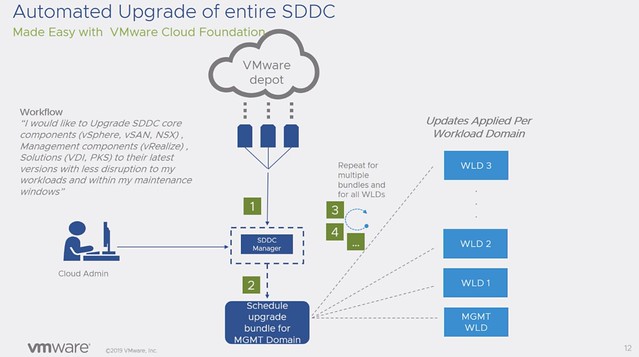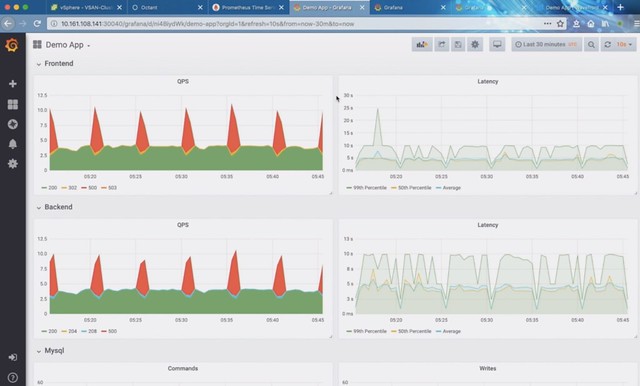I wasn’t able to sit in this session in person, but fortunately, the recording was out within a day. This session has been one of my favorite vSAN related sessions in the past couple of years, and it definitely is one of my favorite sessions this year. Again presented by Christian Dickmann and JunChi Zhang.
In this session, JunChi and Christian will go over some of VMware’s ideas around what HCI Management should look like in the future (HCI1207BU). Christian started by providing an overview of what HCI/vSAN is about today. Christian explained that the world of vSAN was relatively simple in the early years, but today the infrastructures where vSAN is being deployed, and the use-cases, are getting more complex. More and more customers are deploying in various locations and want to manage these solutions in a consistent and efficient way.
The topics which were covered in the session are Lifecycle Management, Intelligent Operations and Cloud Native Apps. JunChi started with Lifecycle Management. JunChi talked about what the vSAN team developed to make life easier when it comes to deploying vSphere. For instance, it is possible to specify in the vCenter Installer that vCenter needs to run on a new vSAN cluster and then the installer will create a single node vSAN cluster to ensure this is possible. Also, the Cluster Quickstart Guide was added, a great way to create and configure a vSphere cluster end to end.
JunChi then spoke about VMware Cloud Foundation and how it enables you to deploy an entire HCI in a fully automated fashion. Starting with vSAN Ready Node configurations, and then layering vSAN, NSX and VCF SDDC Manager on top. JunChi also showed the vCF user experience, which seems super easy. More important in my opinion though is the lifecycle management aspect. SDDC Manager provides this for you. Enabling you to update vSphere, NSX, vSAN, but of course also components like vRealize, PKS and even down to the drivers.

The second topic JunChi discussed was Intelligent Operations. JunChi started with explaining all the current features in vSAN, showing the new capacity views for vSAN for instance. JunChi then asked if customers are using the vSAN Health Check. He then explains what some of the challenges are with vSAN Health Check at the moment, for instance, it is not possible to easily see a historic overview of failed checks. This is something which the engineering and product management team are now considering. Allowing the customer to go back in time to see what the state of the environment was (for instance 8 hours ago). This feature was demoed. In the demo an option was provided to allow you to go back in time (up to 7 days). Very useful when you have intermittent issues in the environment.

Next JunChi discussed VM I/O Insight, which was released in the past as a fling. What this provides you is the ability to determine the I/O patterns of applications. Great solution for customers who need to understand their workloads in order to scale or design an environment. VM I/O Insight today is deployed as an appliance and the idea is to potentially integrate the solution into vSphere, so that the use of the solution is simplified. JunChi also showed a cool demo for this. You simply select the workload through the H5 Client, and I/O Insight will immediately start analyzing the I/O pattern. Of course, it will also show you the results in the H5 Client. Very helpful for those who want to get a better understanding of why the application and the HCI platform is behaving in a certain way.

Then project Magna was briefly discussed, I am planning a separate article on this, so I am not going to describe it in-depth here, but will provide a link later. The other potential upcoming feature that was discussed was a mobile app for vSAN. It would provide you the ability to monitor the state of your cluster from your phone. On top of that, if anything happens, the mobile app will provide push notifications to your phone so that you are aware and can take action if or when required. Seemed very useful to me!

Up next was Christian who was talking about CNA and how vSAN and vSphere integrates with Kubernetes. Christian started with a brief introduction to Project Pacific, Kubernetes, and Containers. Frank has a great post on Pacific, so I am not going to try to explain it. Go here to read it. The key thing to understand is that Project Pacific provides a native Kubernetes experience while fully integrated into vSphere. Christian then goes on explaining what we have delivered in vSAN/vSphere 6.7 U3 around Persistent Volumes for container workloads. (Some extra detail to be found here.) But in short, it enables developers / devops to request persistent volumes for container workloads. These persistent volumes are basically VMDKs which are connected to VMs and within the VMs plumbed into the container. This concept was demoed by Christian, if you are interested in the demo then make sure to watch this one by Myles Gray.
Next Christian demoed Prometheus, which is basically a monitoring solution. In the demo, Christian showed how Prometheus now includes vSphere metrics to provide devops/developers better insight of what their application is doing or why it is behaving in a certain way. Very helpful, especially when you need to troubleshoot a situation where an infrastructure change impacts the application.

Now Prometheus isn’t only useful for developers or DevOps admins, but can also be very useful for virtualization administrators as it also provides a lot of details on vSAN for instance as demonstrated in the screenshot below.

Christian then explained the value of Wavefront, providing even more details then Prometheus and delivered as a Service. So there is no need to install and configure all the different components like Grafana and Prometheus and manage and maintain this. After that Christian summarized the session. Great session, which is definitely worth watching! (You need a VMworld account to access the video.)
Is there anything happening around making it easier to update vSAN clusters, in terms of the hardware drivers and firmware?
We’ve been stuck on 6.7 GA for ages, due to HPE not providing vSAN certified drivers and firmware for the storage controllers.
I have a list of almost 40 issue that we are suffering with as we haven’t been able to upgrade.
It seems that HCI has taken a step backwards, 10 to 15 years ago, when one had to inspect each and every hardware component to match the firmware and driver!
yes this is definitely being worked on by the team.